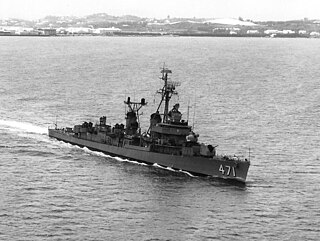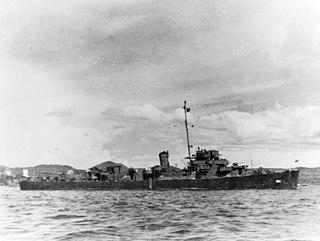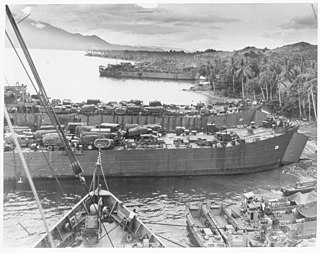USS El Paso (PF-41) was a Tacoma-class frigate manned by the United States Coast Guard for the United States Navy. She was named after El Paso, a city situated in Western Texas and along the border with New Mexico and the Mexican state of Chihuahua.

USS Kilty (DD–137) was a Wickes-class destroyer in the United States Navy. She was the first ship named for Admiral Augustus Kilty.

USS Hutchins (DD-476), was a Fletcher-class destroyer, of the United States Navy named after Naval aviator Lieutenant Carlton B. Hutchins (1904–1938), who though mortally injured, was able to remain at the controls of his aircraft and allow his surviving crew to parachute to safety and was posthumously awarded the Medal of Honor.

USS Beale (DD/DDE-471), a Fletcher-class destroyer, was the second ship of the United States Navy to be named for Lieutenant Edward Fitzgerald Beale (1822–1893).

USS Stevens (DD-479) was a Fletcher-class destroyer in service with the United States Navy from 1943 to 1946. She was finally sold for scrap in 1973.

USS Daly (DD-519), a Fletcher-class destroyer, was a ship of the United States Navy named for Marine Sergeant Major Daniel Daly, (1873–1937), one of the very few people to be twice awarded the Medal of Honor.

USS Russell (DD-414) was a World War II-era Sims-class destroyer in the service of the United States Navy, named after Rear Admiral John Henry Russell. She was among the most decorated US Naval vessels of World War II.

USS Van Buren (PG-150/PF-42), a Tacoma-class frigate patrol frigate, was the second ship of the United States Navy to hold this name. The first Van Buren, a revenue cutter, was named for President Martin Van Buren; the second Van Buren honors Van Buren, Arkansas.

USS Weeden (DE-797) was a Buckley-class destroyer escort in service with the United States Navy from 1944 to 1946 and from 1950 to 1958. She was scrapped in 1969.

USS Manning (DE-199) was a Buckley-class destroyer escort in service with the United States Navy from 1943 to 1947. She was scrapped in 1969.

USS James E. Craig (DE-201) was a Buckley-class destroyer escort in service with the United States Navy from 1943 to 1946. She was sunk as a target in 1969.

USS Eichenberger (DE-202), a Buckley-class destroyer escort of the United States Navy, was named in honor of Ensign Charles Emil Eichenberger Jr. (1920–1942), who was killed in aerial combat on 12 September 1942 during the attack on the Solomon Islands

USS Levy (DE-162) was a Cannon-class destroyer escort, named in honor of Commodore Uriah P. Levy (1792–1862), a notable figure of the 19th-century Navy.

USS Major (DE-796) was a Buckley-class destroyer escort in service with the United States Navy from 1944 to 1948. She was scrapped in 1973.

USS Kenneth M. Willett (DE-354) was a John C. Butler-class destroyer escort acquired by the U.S. Navy during World War II. The primary purpose of the destroyer escort was to escort and protect ships in convoy, in addition to other tasks as assigned, such as patrol or radar picket.

USS Richard S. Bull (DE-402) was a John C. Butler-class destroyer escort in service with the United States Navy from 1944 to 1946. She was finally sunk as a target in 1969.

USS Mahnomen County (LST-912) was an LST-542-class tank landing ship built for the United States Navy during World War II. Like many of her class, she was not named and is properly referred to by her hull designation. She was later named after Mahnomen County, Minnesota, and was the only US Navy vessel to bear the name.

USS Thomason (DE-203) was a Buckley-class destroyer escort in service with the United States Navy from 1943 to 1946. She was scrapped in 1969.

USS LST-22 was a United States Navy LST-1-class tank landing ship used exclusively in the Asiatic-Pacific Theater during World War II and staffed by a United States Coast Guard crew. Like many of her class, she was not named and is properly referred to by her hull designation.

USS LST-26 was a United States Navy LST-1-class tank landing ship used in the Asiatic-Pacific Theater during World War II and manned by a United States Coast Guard crew. Like many of her class, she was not named and is properly referred to by her hull designation.



















